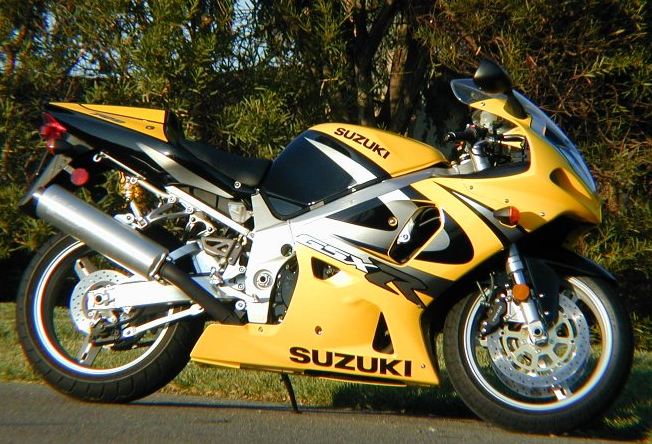
This is part two of our ride review of the 2000 GSX-R750, but we have written even more parts (articles — December 20, 1999 and December 21, 1999) regarding the design and technology of the GSX-R750.
In part one of the ride review on April 12, 2000, I raved about the motor in the 2000 GSX-R750. Since then, I have ridden the bike quite a bit more, in varied conditions, and my opinion of the motor remains unchanged. In the 750 class, you are not going to find a better motor. In fact, this motor reaches toward the open class, with torque and, particularly, peak horsepower that is very satisfying indeed.
But what is it like to ride, and live with the 2000 GSX-R750? Let me begin by discussing the handling. Like the motor, the handling of the GSX-R750 is, in my opinion, a significant step forward. The first thing you will notice is how stable the bike is under all circumstances. This is a function of two design elements.
The first design element contributing to the stability of the new GSX-R750 is the chassis design. The wheelbase is significantly longer this year (six-tenths of an inch longer or 15mm). By itself, this means a more stable bike. With a longer swing arm (20mm longer) and significantly more weight over the front wheel, stability is also enhanced (by keeping the front wheel more solidly planted).
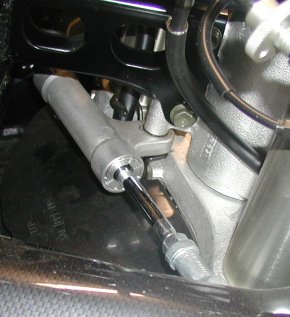
The other contributing factor is the existence of a steering damper installed by the factory on every stock 2000 Suzuki GSX-R750. The non-adjustable damper is, perhaps, a more controversial element contributing to the stable handling of the GSX-R. There are engineers who feel that the use of a steering damper is a “band aid” for poor chassis design. I don’t agree with this, and the facts suggest otherwise.
Ask anyone who races a Yamaha R1, or uses a Yamaha R1 extensively at the track. A steering damper is a must on an R1 under these circumstances, and nobody will argue that an R1 is a poor chassis design. A steering damper can simply be viewed as a prudent handling and safety enhancement device on the most modern, ultra-powerful, ultra-lightweight motorcycles. The 2000 GSX-R750 certainly fits into this category.
Although I haven’t ridden a 2000 GSX-R750 without a steering damper attached, I have no doubt that the basic chassis design contributes to a stable handling motorcycle. If the damper settings were stiff enough to calm an ill-handling motorcycle with this much power, the bike would steer very slowly, and change directions slowly. This is certainly not the case.
The new GSX-R steers extremely well, and also balances a stable feeling (virtually no head shake under any circumstances) with the ability to change directions easily and smoothly.
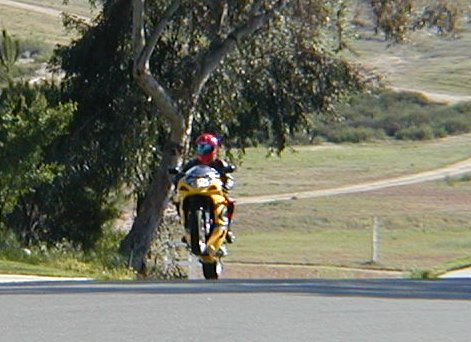
Frankly, I believe that the existence of the steering damper simply enhances the new GSX-R’s handling. It allows you to be much more aggressive on the bike without worrying about head shake forcing you to back off. A bike this light and this powerful will occasionally (and, let’s admit it, sometimes deliberately) have its front wheel in the air, for instance. You feel very relaxed and very much in control when this bike wheelies — in large part due to the steering damper.
The steering damper also contributed to a “planted” feeling in the corners. The greater front weight bias of the new bike (50.5% over the front wheel — versus 50% on last year’s model), together with the longer wheelbase and the steering damper results in a bike that has no “twitchiness” about it — either in a straight line or in a turn. The bike simply tracks very true and very deliberately — without feeling ponderous. It handles beautifully.
On top of all this, should you desire to fit an after-market, adjustable steering damper to this bike (and I probably would), the GSX-R comes ready made with a very trick, very clean, designed-in mounting system for the damper. The damper is attached to the lower triple clamp and the headstock just behind the headlights. It is invisible unless you look for it, yet easily reached should you mount a damper with an adjustment feature. An adjustable damper, of course, should give you the ability to dial-in the handling of your bike to suit the circumstances you are dealing with. Riding a track day and accelerating hard out of bumpy corners? Dial in more damping. Riding in less demanding circumstances, and want the feeling of lighter and quicker steering? Back off on the damping.
Aside from the power the engine produces, I was curious to experience first-hand the new fuel injection system (discussed at length in one of my previous articles linked above). Suzuki claims the new fuel injection design incorporated into the 2000 GSX-R750 dramatically smooths off/on throttle transitions by maintaining (just like a CV carburetor) intake velocity. Providing “seamless throttle response”, and contributing to dramatically improved low and mid-range power, according to Suzuki, this system promises an awful lot. Does it deliver?
My answer came on my ride home to Temecula after I picked up the GSX-R from Suzuki’s headquarters in Brea, California. Forced onto a Southern California freeway at rush hour, I found myself splitting traffic at very low speeds (primarily in second gear) — with lots of off/on throttle transitions. As promised, the bike came on to the throttle very smoothly. In fact, I felt the transition was smoother than some of the better carbureted bikes I had ridden recently. Certainly the best of the fuel injected bikes. Very impressive.
I did notice some off idle “throat clearing” or stumble. This was immediately off idle, however, and did not affect the bike once underway from a stop. I have asked Suzuki whether this was unique to my particular test model (and I even tried to adjust the throttle cables to compensate for this). I could not completely cure the problem, however, and I will let you know if I hear something from Suzuki about this. This was not a significant problem — and was virtually unnoticed most of the time. It would not impact my decision to purchase this bike.
As I previously stated (in part one of this ride review), in all other respects the motor is truly impressive. For all intents and purposes, on the street, an open class bike is overkill, and this 750 has more motor than you will need. Look at it this way. Do you want to drag race an R1 on the street? Probably not, and it would certainly be illegal, but this bike would do it and handle the task quite well. Would it win? I don’t know, I’ll let the print mags’ shoot-outs tell you the answer to that question. Anything short of this, the GSX-R750 will handle with ease.
The bike accelerates phenomenally. In the around-town mid-range (4,000 to 8,000 rpm) the bike is quite quick. Above 9,000 rpm, the 2000 GSX-R750 simply, and resolutely, tears the street apart.
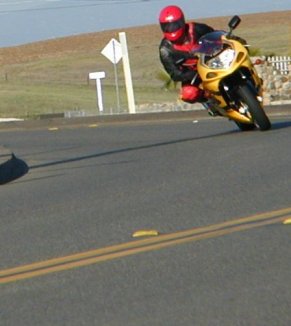
The bike also accelerates very quickly at high speed — very much like an open class bike. Contributing to this, undoubtedly, is highly developed aerodynamics. Remember, this is Suzuki’s homologation of its AMA and World Superbike racer. This fairing design is intended to be slippery — and it is. Somewhat surprisingly, the fairing also provides decent wind protection at freeway speeds.
This brings us to ergonomics. I have to begin this discussion by pointing out that this motorcycle, quite obviously, is a “racer with lights”. The foot pegs are quite high, even by sportbike standards. The reach to the bars is less severe and, overall, as a 43 year old who gets stiff in the morning (you know what I mean), I nevertheless got off the GSX-R after riding virtually all day (roughly 200 miles on the bike during one particular day) without feeling stiff or uncomfortable.
Something I didn’t really notice was the seat. This is a good thing. I notice seats when they become uncomfortable. The GSX-R has a comfortable seat.
The bottom line on ergonomics. This is a committed race riding position which is not intended to be comfortable for long periods in a straight line. Nevertheless, while “sport riding” for extended periods of time, combining “twisties” with freeway and other straight highway mileage, I remained reasonably comfortable. Taller riders with long inseams (I am 5’11” with a 32 inch inseam) will find the foot peg position quite high on this bike, however. The reach to the bars should be comfortable for most riders — short or tall.
The other aspect of ergonomics is not comfort, but control. Here, the GSX-R750 scores very high. The riding position does make you feel the motorcycle is working with you. The main purpose of owning a GSX-R750, rather than a Goldwing, is to “cut and thrust”. The riding position is very much intended to enhance this function. You can move and shift your body on this motorcycle very easily. In full-on, sport riding mode, while shifting your weight to the inside of corners, the GSX-R works beautifully, and allows you to move the way you need to move on the bike without feeling unnatural or hindered in any way.
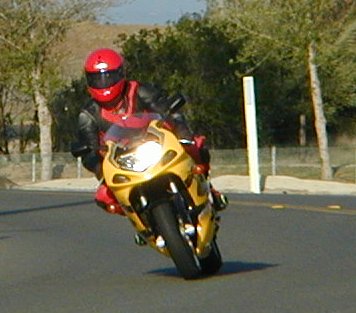
The transmission is also something I didn’t really notice. Again, this is a good thing. The bike shifts easily and naturally. I did not find a single “false neutral” in several hundred miles of riding. I never felt that the shift lever pressure required to change gears was too much or too little. The position of the shift lever felt fine to me (I wear size 10, Alpinestars boots).
Clutch action was smooth and relatively light. No clutch fade was experienced. Clutchless up-shifts are accomplished easily and with confidence.
I did not get a chance to take this bike on to the race track (I had planned to, but my plans necessarily changed). The race track tells me an awful lot about brakes. Without that experience, I can only tell you that the brakes worked very well in street riding conditions. I was riding aggressively, at times, and, under those circumstances, I brake with both the front and rear brake, trail braking somewhat into corners. I felt good balance between the front and rear brake, and I was able to modulate braking power well. What I can’t tell you is how much feel and feedback you get when braking near the limits of traction — I just didn’t do this on the street. Reports I have read indicate that the brakes work quite well on the race track, however, and I have no reason to doubt it.
The GSX-R’s brakes went from six-piston calipers to four-piston calipers up front this year. The disc diameter in front remains the same (320mm). The four-piston calipers are clearly lighter (the primary reason for the change), and four-piston calipers can be exceptionally functional. Yamaha’s outstanding front brakes feature four-piston calipers (both R1 and R6), as does Honda’s new 929RR (which has stupendous brakes — I did test those on the race track). The switch from six-piston to four-piston calipers, therefore, does not concern me in the least.
My U.S. model wears Dunlop D207 tires. Along side Michelin Pilots, D207s are the best available sportbike rubber. The tires performed well.
The instrumentation, including speedometer, tachometer, and (subject to toggle switching) odometer, trip meter number one, trip meter number two, engine temperature and time (expressed in military time) was easy to read and easy to operate (operate meaning toggle between functions and reset trip meters).
The fuel tank holds 4.8 gallons, and the GSXR provided between 30 and 35 miles per gallon during my use of the bike. Your mileage should be better, however, for two reasons. After breaking in a motor (the bike I rode had 55 miles on it when I took delivery), mileage will increase. Mileage will also increase through “normal” riding (I rode very aggressively during the short time I had a chance to use this machine).
The fully-adjustable suspension (compression, rebound, and spring preload — both front and rear) worked well on the street. I never changed the settings of either the shock or the fork. I weigh roughly 195 pounds, and the damping appeared to be a good compromise between comfort and performance. It was reasonably stiff during spirited riding through the corners, but not uncomfortable while cruising on the freeway. As I said, I didn’t test the damping or preload adjustments on the bike, but I would be surprised if the fork and shock could not be set up much stiffer for track use without re-valving them. Serious racers, of course, will probably re-valve the stock suspension, or even purchase an after-market shock (such as an Ohlins).
Use of the rearview mirrors requires movement of your elbows. If you’ve ridden a modern sportbike for any length of time, it has become second-nature for you to move your elbows in order to obtain a clear view behind. The rear view mirror stalks on the GSX-R are not long enough to avoid this necessity. The mirrors also vibrated at freeway speeds enough to blur the view. Nevertheless, the mirrors served their purpose and allowed me to make lane changes and other maneuvers the way I normally would.
The paint and the finish on the bike is excellent. I really like the look of the bike — I thought I would prefer the blue and white model, but the yellow and black is even better looking, in my opinion.
Mat Mladin won the AMA Superbike championship and this year’s Daytona 200 on a GSX-R750. Frankie Chili has made the podium in World Superbike on a GSX-R. Those bikes were built on the foundation of last year’s GSX-R750 — this year’s bike is better . . . much better.
The 2000 Suzuki GSX-R750 will be available through United States dealers in roughly two weeks at an MSRP of $9,399.





